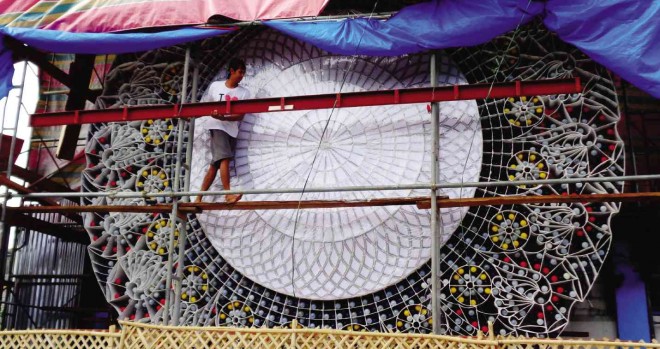
STAR OF BETHLEHEM No other place in the Philippines makes giant Christmas lanterns like the City of San Fernando in Pampanga province. Local craftsmen make replicas of the Star of Bethlehem that, as the Bible story goes, guided the Three Wise Men in their search for the Child Jesus. TONETTE OREJAS
Why would 10 villages in the City of San Fernando in Pampanga province spend at least P600,000 each to build a giant lantern when government subsidy amounts to only P170,000 each and the top prize is only P130,000 in this year’s 106th Ligligan Parul (Giant Lantern Festival)?
The cost is as enormous as the lantern’s size. But craftsmen in San Fernando, the only place in Pampanga where the tradition is sustained, persist in making giant lanterns despite the expense.
Arnel Flores, 44, a maker of winning lanterns, offers two reasons. “It’s done to bring honor to our village. We have to continue our tradition,” he says as he and his coworkers, including his son, Mark Niño, 19, put the finishing touches on their entry.
His village, Telabastagan, located in the northern tip of the city, emerged champion in 2007 and 2008. The much-coveted grand slam did not happen as the winning streak stopped in 2009 when Flores’ masterpiece placed second.
Telabastagan regained the grand prize in 2013 and is aiming to retain it this year.
Honor, Flores says, is not about earning the right to brag about having the most beautiful and most colorful lantern. “It’s a kind a honor that brings respect to everyone in the community,” he says.
The honor goes also to his mentor, the late Toto Bondoc, who learned the techniques and designs from Ernesto Quiwa and the late Mario Datu.
Spirit of cooperation
But what sustains this unique Christmas tradition of having 10 giant lanterns on parade and “dance” in perfect sync with an accompanying music is the spirit of cooperation among villages, says Mayor Edwin Santiago.
“Mipapanyaup” or “misaupan-saupan” (helping each other) is how this spirit goes in the Kapampangan language. Robinsons Starmills joined this community effort and donated P2.426 million to help mount the festival.
Back in the 1930s, the contributions ran from 50 centavos to a peso, according to Angelo David, 82. Now, it remains to be voluntary, in cash, materials or labor.
Edwin David Jr., 32, says Catholics in the city must be so enamored with the Star of Bethlehem that they want to display its modern replicas during Christmas. As the Bible story goes, that star guided the Three Wise Men in their search for the Child Jesus.
For Barangay San Nicolas, David has designed a 6.09-meter (20 feet) lantern with 7,500 bulbs and eight rotors.
Rotors are aluminum sheets rolled into a drum. Parts of its surface are exposed or covered by masking tape. The rotor is connected to the source of the electricity, through metal hair pins or bicycle wheel rods. Moving it exposes the surface to electricity, thus turning the light bulbs on.
David sticks to an old lantern style that Barangay San Nicolas is known for—using a thick clear plastic sheet covered with white stickers in geometric shapes or flowers. His father and namesake learned this and other aspects of lantern making from the late craftsman Juaning David.
Honor and tradition
Eric Quiwa agrees with Flores and David that honor and tradition compel lantern makers to pass the techniques to the next generation.
But Quiwa, a fifth-generation lantern maker who descended from the pioneer, Francisco
Estanislao, puts more emphasis on the rotor.
“It’s not the number of bulbs that you put into a lantern that will make it beautiful. The fight is won on the rotor because that is where the designs are actually executed,” he says.
The lanterns he made for the villages of Sta. Lucia and Calulut have eight and 12 rotors, respectively.
Lantern makers say the community endeavor brings them pride. It is largely unknown that they have not earned college degrees yet they are able to make very complicated pieces that astound the senses.
Roland Quiambao, whose works had been displayed in exhibits overseas, recalls times when engineers went backstage and checked if his lanterns were operated by computers.
“Told that everything was made by hand, they scratched their head or showed amazement. I tried to explain how the rotors work and they are more in awe,” Quiambao says.